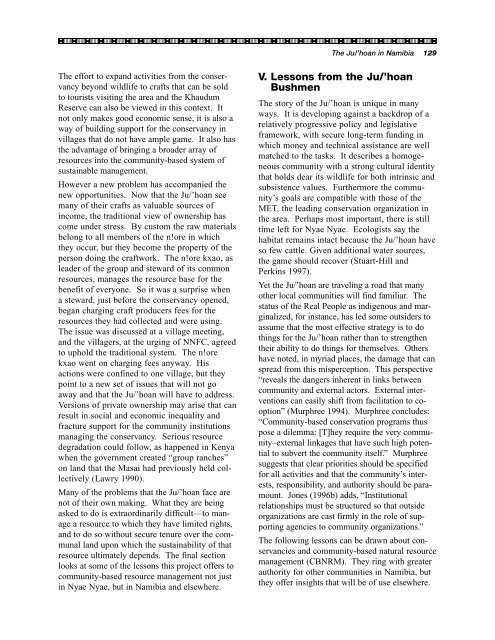Indigenous Peoples and Conservation Organizations
Indigenous Peoples and Conservation Organizations
Indigenous Peoples and Conservation Organizations
You also want an ePaper? Increase the reach of your titles
YUMPU automatically turns print PDFs into web optimized ePapers that Google loves.
The Ju/’hoan in Namibia 129<br />
The effort to exp<strong>and</strong> activities from the conservancy<br />
beyond wildlife to crafts that can be sold<br />
to tourists visiting the area <strong>and</strong> the Khaudum<br />
Reserve can also be viewed in this context. It<br />
not only makes good economic sense, it is also a<br />
way of building support for the conservancy in<br />
villages that do not have ample game. It also has<br />
the advantage of bringing a broader array of<br />
resources into the community-based system of<br />
sustainable management.<br />
However a new problem has accompanied the<br />
new opportunities. Now that the Ju/’hoan see<br />
many of their crafts as valuable sources of<br />
income, the traditional view of ownership has<br />
come under stress. By custom the raw materials<br />
belong to all members of the n!ore in which<br />
they occur, but they become the property of the<br />
person doing the craftwork. The n!ore kxao, as<br />
leader of the group <strong>and</strong> steward of its common<br />
resources, manages the resource base for the<br />
benefit of everyone. So it was a surprise when<br />
a steward, just before the conservancy opened,<br />
began charging craft producers fees for the<br />
resources they had collected <strong>and</strong> were using.<br />
The issue was discussed at a village meeting,<br />
<strong>and</strong> the villagers, at the urging of NNFC, agreed<br />
to uphold the traditional system. The n!ore<br />
kxao went on charging fees anyway. His<br />
actions were confined to one village, but they<br />
point to a new set of issues that will not go<br />
away <strong>and</strong> that the Ju/’hoan will have to address.<br />
Versions of private ownership may arise that can<br />
result in social <strong>and</strong> economic inequality <strong>and</strong><br />
fracture support for the community institutions<br />
managing the conservancy. Serious resource<br />
degradation could follow, as happened in Kenya<br />
when the government created “group ranches”<br />
on l<strong>and</strong> that the Masai had previously held collectively<br />
(Lawry 1990).<br />
Many of the problems that the Ju/’hoan face are<br />
not of their own making. What they are being<br />
asked to do is extraordinarily difficult—to manage<br />
a resource to which they have limited rights,<br />
<strong>and</strong> to do so without secure tenure over the communal<br />
l<strong>and</strong> upon which the sustainability of that<br />
resource ultimately depends. The final section<br />
looks at some of the lessons this project offers to<br />
community-based resource management not just<br />
in Nyae Nyae, but in Namibia <strong>and</strong> elsewhere.<br />
V. Lessons from the Ju/’hoan<br />
Bushmen<br />
The story of the Ju/’hoan is unique in many<br />
ways. It is developing against a backdrop of a<br />
relatively progressive policy <strong>and</strong> legislative<br />
framework, with secure long-term funding in<br />
which money <strong>and</strong> technical assistance are well<br />
matched to the tasks. It describes a homogeneous<br />
community with a strong cultural identity<br />
that holds dear its wildlife for both intrinsic <strong>and</strong><br />
subsistence values. Furthermore the community’s<br />
goals are compatible with those of the<br />
MET, the leading conservation organization in<br />
the area. Perhaps most important, there is still<br />
time left for Nyae Nyae. Ecologists say the<br />
habitat remains intact because the Ju/’hoan have<br />
so few cattle. Given additional water sources,<br />
the game should recover (Stuart-Hill <strong>and</strong><br />
Perkins 1997).<br />
Yet the Ju/’hoan are traveling a road that many<br />
other local communities will find familiar. The<br />
status of the Real People as indigenous <strong>and</strong> marginalized,<br />
for instance, has led some outsiders to<br />
assume that the most effective strategy is to do<br />
things for the Ju/’hoan rather than to strengthen<br />
their ability to do things for themselves. Others<br />
have noted, in myriad places, the damage that can<br />
spread from this misperception. This perspective<br />
“reveals the dangers inherent in links between<br />
community <strong>and</strong> external actors. External interventions<br />
can easily shift from facilitation to cooption”<br />
(Murphree 1994). Murphree concludes:<br />
“Community-based conservation programs thus<br />
pose a dilemma: [T]hey require the very community–external<br />
linkages that have such high potential<br />
to subvert the community itself.” Murphree<br />
suggests that clear priorities should be specified<br />
for all activities <strong>and</strong> that the community’s interests,<br />
responsibility, <strong>and</strong> authority should be paramount.<br />
Jones (1996b) adds, “Institutional<br />
relationships must be structured so that outside<br />
organizations are cast firmly in the role of supporting<br />
agencies to community organizations.”<br />
The following lessons can be drawn about conservancies<br />
<strong>and</strong> community-based natural resource<br />
management (CBNRM). They ring with greater<br />
authority for other communities in Namibia, but<br />
they offer insights that will be of use elsewhere.

















